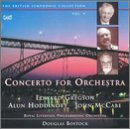| All Artists: Lewis / McCabe, John / Gregson, Edward / Hoddino Foreman, Edward Gregson, Alun Hoddinott, John [1] McCabe, Douglas Bostock, Royal Liverpool Philharmonic Orchestra Title: Concerto for Orchestra Members Wishing: 0 Total Copies: 0 Label: Classico Release Date: 5/21/2002 Album Type: Import Genres: Special Interest, Classical Styles: Forms & Genres, Concertos, Symphonies Number of Discs: 1 SwapaCD Credits: 1 UPCs: 675754508722, 5709644016372 |
Search - Lewis / McCabe, John / Gregson, Edward / Hoddino Foreman, Edward Gregson, Alun Hoddinott :: Concerto for Orchestra
 | Lewis / McCabe, John / Gregson, Edward / Hoddino Foreman, Edward Gregson, Alun Hoddinott Concerto for Orchestra Genres: Special Interest, Classical
|
Larger Image |
CD Details |
CD ReviewsNeo Baroque Splendor Thomas F. Bertonneau | Oswego, NY United States | 02/16/2003 (5 out of 5 stars) "The designation "Concerto for Orchestra" originates with Paul Hindemith, who applied it in 1925 to a brief three-movement work for the Berlin Philharmonic under Wilhelm Furtwängler. Hindemith's work is in his densely contrapuntal but cheekily ironic "Back to Bach" style of the decade just after World War One and harkens back to the baroque notion of a "Concerto Grosso." The principle of the "Concerto Grosso" is to let solo instruments or groups of solo instruments come into prominence now and then in what is primarily an orchestral composition. In the late Eighteenth and early Nineteenth Centuries, the "Concerto Grosso" metamorphosed into the "Symphony Concertante," with notable examples being contributed by Haydn and Mozart. Hindemith's 1925 "Concerto for Orchestra" gives prominence in its different sections not so much to individual instruments as to instrumental sections of the orchestra: now the brass, now the woodwinds, now the string quartet. Bela Bartók famously revived Hindemith's nomenclature for the score that Sergei Koussevitsky commissioned from him in 1943. Bartók's, of course, has become THE "Concerto for Orchestra." Bartók also provided the inspiration to dozens of composers who came after him who discovered that, in the academic atmosphere of the 1950s and 60s and 70s, works bearing the name of "symphony" were suspect and largely unwanted, except if they adhered to the serial chromaticism that had become the language-by-demand of the musical establishment. If, on the other hand, one gave one's basically symphonic composition the title of "Concerto for Orchestra," then one might find a place for it in the subscription programs or on record. The brilliance and playfulness connoted by the idea of a "concerto" assuaged the puritanical law that dictated that no music should ever actually please its audience. One result of this was that the "Concerto for Orchestra" became a legitimate genre of its own, related to but distinct from what is called a symphony. The trio of "Concertos for Orchestra" recorded by Douglas Bostock and the Royal Liverpool Philharmonic Orchestra for the Classico label provides three instances. Edward Gregson's (born 1945) "Contrasts: A Concerto for Orchestra" (1983) is in three sinewy movements: A fanfare-dominated "Intrada," a lyric "Elegy" in which the string band takes on the major role, and a percussive "Toccata" in which all the instrumental choirs get their turn. As one might imagine on the basis of the baroque movement-titles, Gregson is fond of the archaic forms of fugue, chorale, and passcaglia. So, too, is Welshman Alun Hoddinott (born 1929), whose "Concerto for Orchestra" (1986), who combines them, however, with a slightly more aggressive (but by no means off-putting) harmonic language than that used by Gregson. It is a shame that Hoddinott is not (!) more widely recorded. (The Lyrita CDs of his symphonies have sadly gone out of the catalogues.) Here again we have three movements: a "Vivo," an "Adagio," and a "Presto," the second of them resembling, as in Gregson's "Concerto," a passacaglia. John McCabe (born 1939) opts for a one-movement work subdivided into many sections and unified by the use of a subtle theme-and-variations technique. Both Gregson and Hoddinott like brash colors, kept distinct and deployed in great blocks of sound; McCabe uses a blended palette. There is something of impressionism in his style. All three of these works are rewarding to the listener, as well as providing a work-out for one's stereo system. I strongly recommend this disc, which, I predict, will one day be a much sought after collector's item."
|

 Track Listings (16) - Disc #1
Track Listings (16) - Disc #1